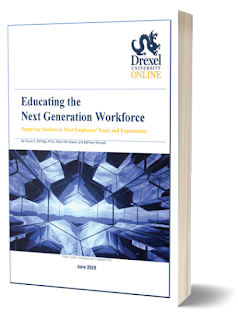Half an Hour,
Oct 08, 2019
Summary of 'Educating the Next Generation Workforce: Preparing Students to Meet Employers' Expectations' by Susan Aldridge, President (ret), Drexel University
There are new types of jobs for students gradauating today, and new learning opportunities in igital labs, etc. Technology has enhanced our lives. So it has become crucial for higher education to evolve.
Drivers and trends: demographics, AI, Wifi and Mobile, new tech, etc. Eg., for engineering students starting today, many of the things they learn will be out of date when they graduate.
Some examples of disruption:
- 75 million jobs will be lost or massively disrupted by 2025
- 133 million roles new roles may emerge - New jobs like 'personal privacy advisor' or 'space tourism guide'
- By 2020 Millennials and Gen Z will be 70% of the workforce
- 2/3 of the words population are mobile users - 57% of the world is connected - this paves the way for mobile learning
Some trends:
- 5G and internet of things - we will go beyond smart homes to smart cities.
- Flexible working arrangements - millennials want flexible learning - Paul Miller says 'requesting flexible work has become a right in some countries.
- trend toward virtual work and learning - it is a revenue opportunty for universities, employers save on office space - saving $20,000-$37,000 per employee per year
All of this is also driving new education models, from online programs to PD opportunities, to remote and freelance options as well.
So we need to move beyond traditional degree-based learning and move toward lifelong self-paced learning. We already need this now. This will also require that industry lead the skills-gap dialogue, and educational institutions adapt rapidly to meet these needs.
No matter what else - universities have to focus on digital literacy to support this kind of learning, hiring faculty who are digitally literate.
Also, they need to take advantage of augmented and virtual reality. Lists of areas where VR/AR support learning. Now there are about 150 million people using AR/VR. This market is going to continue to grow. They provide access to learning environments students couldn't get any other way. Eg. where environments are hazardous, such as flight simulation.
Kai-Fu Lee - Automation will replace 40% of jobs - but 150 million news jobs will be created in the meantime. Humans are moving away from repetitive tasks, and moving toward tasks only humans can do. Eg. automated driving, personalized music playlists, etc. But AI couldn't tell which of you in this room is the best looking.
A company, SenseTime, went from being an academic pobject to the world's most valuable AI company - current valuation of $4.5 billion. It operates mostly in China. It does face recognition, image and object recognition, remote sensing, autonomous driving, etc. It is now the largest algorith provider in China.
Another major AI technology: face and voice recognition. Most use cases fall into three categories: security (eliminate passwords), health care, marketing (even though most of us don't want this). Also this is used in natural language translating.
More examples of companies with AR/VR products - car companies, etc. HUD displays. Retinal display. Microsoft HoloLens. Also - $4 VR headset for smartphones.
Connections to Learning
Imagine sending students to ancient battles, outer space, or into the human body. VR gives a new meaning to the word 'field trip'.
Case Western University and the Cleveland Clinic - use of the MS HoloLens. Various other universities are following suit. VR First - a global program to support learning using this technology.
VR Education apps include:
- apps fcused on science and health care, arts, history, language learning
- anatomU - take a tour through the body
- inMind - travel through the brain
- Titans of Space - VR space tour of the Solar System
- Aeon's King Tut VR
- BBC produced an experience based on the Berlin Blitz from inside the airplane - https://www.bbc.co.uk/mediacentre/latestnews/2018/berlin-blitz-vr
Drexel University
- VRtifacts+ - VR artifacts for courses
- created a repository of more than 500K artifacts - all OER
The best examples are where learning and work come together
- VR first Auggie awards to recognize this - over 1000 projects, 39 countries
- vr flight simulator for surgery
Businesses are deploying more quickly than universities - training is a cost centre for them, but they also need results. Eg. new project by WalMart.
So how do we keep pace? The World Economic Forum says there are no less than 54% of employees that need reskilling by 2025. (Video of Amazon Sumerian - proof-of-concept - avatar 'Cora'.)
Also: gamification in the workplace.
(Video: ASCE Future World Vision project - five types of cities)
Content for this talk from a new white paper:
https://virtuallyinspired.org/educating-the-next-generation-workforce/
(Requires you give personal information)
Mentions
- Educating the Next Generation Workforce: Preparing Students to Meet Employers’ Expectations, Feb 13, 2020, - , Feb 13, 2020
, - , Feb 13, 2020





